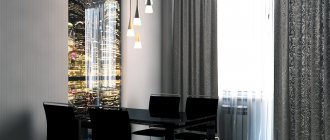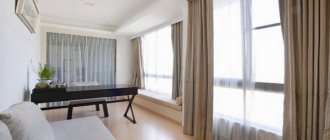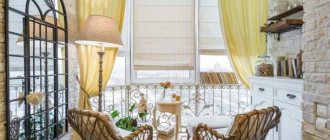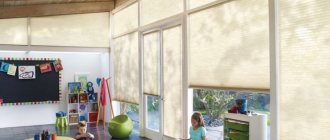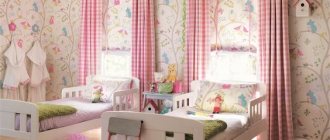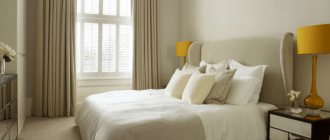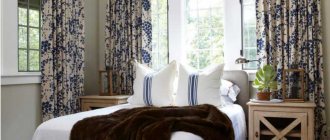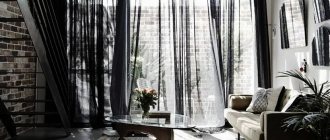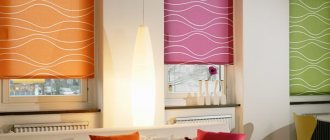When an apartment is being decorated, every owner wants the result to be the ideal option. Much attention is paid to color, because it is it that can create a special atmosphere in a room. Convenient and comfortable furniture is selected, and decorative elements that make the interior individual and unique are not complete. But in order to complete the overall picture and achieve harmony, you need to pay maximum attention to the choice of curtains. They are the final and main element in the entire design of the room. Particular attention should be paid to such a room as the bedroom, because there you need to achieve an atmosphere of comfort and tranquility. There are several options for what classic bedroom curtains will allow you to achieve the perfect result.
Curtains for the bedroom photo
Back to contents
Rules and recommendations for selection
Classic curtains will be no less appropriate in a modern interior than in a classic style, but there are other features that need to be taken into account when choosing them.
- You need to select the width of the curtains according to the size of a particular window, otherwise it may look disproportionate.
- Abundant folds and tassels will look good on the wide and tall windows of the hall.
- Dark and deep shades of burgundy, green, and blue will be appropriate only in spacious rooms; for small living rooms and bedrooms, classic-style curtains with tulle and a small lambrequin are suitable.
- Sophistication lies in the right choice of material. The classic style does not accept synthetics; noble fabrics are acceptable: velvet, silk, satin.
Signs of classic curtains are the presence of tulle, sliding curtains with or without a tie, dense fabric material, long panels, and elegant folds.
In modern classics, a combination of textures and types of curtains is acceptable, which does not harm the overall appearance of the interior. For example, classic curtains can be combined with Roman or roller blinds, and airy tulle with blinds.
Curtain color scheme
Proper selection of colors in the bedroom helps you relax and feel privacy. For this room it is better not to choose bright or harsh colors.
The most suitable colors will be:
- White
- Pink
- Beige
- Blue
- Creamy
- Creamy pink
- Lilac
- Grey
- Violet
Important! You should be careful with white in the bedroom, as such curtains can quickly get dirty or create a cold feeling of sterility. To prevent this from happening, it is better to choose textured tulle with embroidery, lace or decoration and thick threads.
Gray color can make the interior too boring. Therefore, in this case, it is better to choose fabrics in light colors and use them in a room where there are other colors: pink, blue, lilac, green.
An interesting solution for curtains in the bedroom would be a combination of tulle of different colors. It can be multi-layered or created from pieces of colored fabrics hung in one row.
Whatever the curtains are in the bedroom, they should create coziness and warmth so that you want to truly relax in this room.
Types of curtains
Today, the curtain market offers a wide selection of window decoration options, which modern designers successfully use to create a unique interior.
- Classic Roman blinds are a fabric that, using an opening system, forms parallel folds. They can be attached both to the window and to the window opening. They look aesthetically pleasing, are suitable for a small room, and are easy to care for.
- Classic long curtains can fall to the floor or slightly reach it. The curtains are gathered at the sides using decorative ties and complemented by a light curtain that is slightly gathered into waves. Such curtains look luxurious due to the material, but also require special care.
The photo shows an example of a bedroom in a classic style, where the curtains fall from a niche, which makes the window visually larger.
- French curtains create an atmosphere of theater and celebration due to translucent waves on high and wide windows. Stationary French curtains can be used as tulle in addition to curtains, and a curtain with a lifting mechanism can be assembled into a lambrequin.
- You can decorate the space above the window with a lambrequin, thereby making it visually higher. The lambrequin is not adjustable in height; it can be hard or soft, be the same color as the curtains, or become a contrasting accent.
The photo shows an example of a living room with a rigid lambrequin, inside of which a cornice is hidden, which gives an aesthetically complete look.
Features of curtains in a classic style
The main features of this style:
Classic curtains do not tolerate excessive simplicity, too laconic designs and too bold experiments.
Choosing the design and color of curtains
It is important to choose not only the material and type of curtains, but also a color that can visually expand the space, resonate with decorative elements and simply change the perception of the room.
You can choose curtains that will become a bright accent, but will have a similar pattern to the wallpaper or the same pattern as on the upholstered furniture. Also, curtains can be combined in color with upholstered furniture or walls. A win-win option is to choose classic-style curtains to match the color of the kitchen facade, large living room carpet or bedroom bedspread.
Light shades increase the space, deep warm shades reduce it, this must be taken into account when choosing curtains for a small room.
In the classic style, white and cream, beige colors will always be appropriate, which can be diversified with a brown garter or bright edging, fringe, and tassels.
In order to focus attention on the window, you can choose curtains with wide stripes, where 2 or 3 colors are smoothly combined.
Plain curtains will go well with wallpaper with a pattern or design, in this case the interior will not be overloaded. If the wallpaper is plain or has a light texture, then you can choose curtains with patterns or ornaments to match the color of the wallpaper. Classic style curtains with a pattern would be appropriate in a children's room.
Design
If the design of curtains is thought through to the smallest detail, they can become the hallmark of the room. A window in a classic style is decorated with two panels of curtains and decorated with a lambrequin. Curtains on both sides are secured with holders or braid. The set should also include a transparent curtain made of thin fabric.
The combination of dense and thin fabrics, carefully thought out colors, creates the impression of good quality, nobility and elegance. It is important to select curtains that match the overall interior of the room. If they do not match in color, it will look ridiculous and ugly.
Selection of material, fabric characteristics
Classic style curtains are distinguished by the nobility of the fabric, which is widely represented and has a time-tested reputation.
- Silk has high strength, stretches well, does not let the sun's rays through, shimmers beautifully in the light, and drapes well.
- Taffeta is dense to the touch, drapes in wide folds, repels moisture, and lasts a long time with proper care.
- Satin is a durable silk material with a characteristic shine. Dries quickly and does not accumulate static electricity. It is important not to overdry the fabric and wash it at a low temperature.
The photo shows an example of window design in a classic style, where the curtains and lambrequin are made of the same material, and inserts with a floral pattern act as a bright decor.
- Brocade is a silk-based fabric with Lurex embroidered patterns. It is distinguished by its weight and density. Hard material, hard to wrinkle.
- Velvet is a dense material with fine pile of silk fiber. Absorbs moisture, has a long service life, does not attract dust, drapes well, retains heat, and allows air to pass through.
The photo shows an example of how velvet curtains can look light due to color and protect from the sun at the same time.
- Jacquard fabric has a large pattern, density, abrasion resistance, retains color well, and does not stretch. Washable at low temperature, do not wring.
- Chenille fabric has high wear resistance, is pleasant to the touch, retains color well, drapes easily, and is available in a wide selection of composition, color and pattern.
Variety in choice
Looking at different photos of classic curtains, you will notice that their design is rarely repeated. Fabrics, accessories, fastening methods and even the threads used can provide originality.
Note!
- Curtains on the door: purpose, methods of application and types of door curtains. Pros and cons of use (photo + video)
- Curtains for a small kitchen: criteria for choosing curtains for a small kitchen, choosing the size and length of curtains. Colors, patterns and types of curtains (photo + video)
- Ceiling curtains - features of the design solution. Choosing the shape and design of the cornice. Features of base materials (photo + video)
Thanks to the addition of lurex threads, the use of viscose and cotton, their combination with long-known fabrics allows you to create a set that will last for many years.
Types of classic cornices and fastenings to them
An important role is played not only by the material, but also by the appearance of the cornice, as well as the strength of fastening the curtains to it.
- Baguette cornices are best suited to the classic style. The fasteners are not visible behind the bar, which makes the window look complete. The baguette can be plastic with imitation of forging or wood, smooth or carved.
- Tubular cornices can be single-level or two-level, decorated with finials at the edges and made to a specific size.
The photo shows an interior with a wooden tubular cornice, on which there are translucent curtains with a floral print and garters. Here is a classic in simplicity and elegance.
- Profile cornices are convenient for decorating bay windows or corners. Mounts both on the wall and on the ceiling. Made from profile aluminum.
- A forged cornice will attract attention, so curtains should be simple. This cornice is suitable for heavy fabrics. The best method of fastening would be eyelets and rings.
- Wooden cornices can be ceiling, wall, tubular and baguette. The natural shade of wood will fit into the classic interior of any room.
The photo shows a wooden baguette in a classic style design, from which weightless tulle and smooth pastel-colored curtains fall.
Curtains can be attached to the curtain rod in different ways, depending on the weight of the fabric and the style of the room.
- Eyelet fastening is suitable for a modern classic style. This is a fastening method in which rings are sewn into the curtain fabric; it is more suitable for curtains.
- When attached to rings, the fabric is fixed on hooks, and the rings are strung on a tubular cornice.
- Classic curtains with ties look original and varied due to different tying methods (bows and different types of knots). In addition, the color of the ties may differ from the color of the curtains.
- Fabric loops, like eyelets, are threaded onto the cornice. The width of the loops and their number depend on the weight of the curtains. The loops can be on clips, in the form of braids, or sewn to the fabric.
- The drawstring hides the top of the cornice due to the high frill. This fastening is suitable for niche windows, tubular cornices, and cafe curtains. When moving, you will hear a slight rustling of the fabric, and not the knocking of rings on the cornice.
- Curtains with braid look simple and elegant due to the frequent small folds that are formed due to the tightening of the laces to the desired limit. For lush drapery, fabric should be 2 times the size of the window.
Popular Trends
This year, classic curtains made from natural materials, painted in natural colors, will be popular. The most popular fabrics for curtains this season are silk, linen, cotton, organza, jute and bamboo. Synthetic threads are added to linen and bamboo fabrics, which makes the curtains wear-resistant and durable.
This year, designers advise using laconic and simple curtains in the home. The main criteria are also practicality and wear resistance. From the color range, as already mentioned, it is best to choose natural, natural colors - green, gray, brown, blue and blue. Blue curtains fit almost any interior, refresh the room, make it light and airy.
White also remains popular. Visually enlarges the room, making it fresh and clean. White tulle and blue curtains with ornaments look interesting.
Curtains are full-fledged decorative elements in any room, so you should pay special attention to their appearance. Designers offer many interesting ideas for decorating windows with classic curtains, so everyone can find a suitable option for themselves.
Decorative accessories
The beauty of the classic style lies in the luxury and abundance of richness that the details bring. Curtains are decorated with functional accessories, such as:
- Holders made of wood or metal, which are mounted on the wall, hold the shape of the drapery and decorate the curtains. Also, holders can be magnetic, fabric or ribbon.
The photo shows an example of draping curtains and fixing them using holders. The classic mounting height is window sill level.
- The pickups control the light level, are easy to use, and can be changed frequently. They come in the form of hairpins, beads, fabric, ropes. They differ from holders in that they are not attached to the wall.
- Brushes help give the curtains the desired shape and hold it. Also, small tassels can be used to decorate a lambrequin or the edge of a fabric.
- A lambrequin with numerous flaps is suitable for decorating a window in the living room. It may be made of a different material and a contrasting color; in this case, it is important not to overload the room with other decorative elements.
The photo shows an example of how a lambrequin can decorate not only the living room, but also the kitchen.
- In the classic style, fringe decorates the border of the curtains. It can be of different lengths, with beads, bugles and beads, with tassels and weaving.
Color selection
Such an important process as choosing a color can sometimes bring a lot of difficulties. This is due to the fact that a seemingly chic model, ideally suited to the interior of the room, is irrelevant in the bedroom and does not harmonize with the furniture elements. It’s good when it is possible to change the model to a more suitable one, then the owners will only waste time. To avoid such situations, there are basic rules that will help prevent mistakes:
Calm colors for the bedroom photo
- The first thing you need to do is decide what the curtains should go with. Most often, a color or pattern is selected to match the walls or furniture. But you need to understand that if the walls have several color combinations, it is not necessary to use the same colors in the curtains. It is acceptable to choose only one color, especially if the furniture also combines several colors.
- It is impossible to use curtains in dark colors for small bedrooms; they will visually reduce the area and it is unlikely to achieve an atmosphere of coziness and comfort.
- In order to visually increase the height of the ceilings, models with vertical stripes are used. So that they do not look difficult, you need to choose a delicate, light tulle, then dark curtains, for example, in chocolate tones with a light stripe, look very elegant and sophisticated.
- In order to visually increase the space, use plain light models. In addition, snow-white or beige tones are combined with almost all interiors, so it is quite difficult to make a mistake when choosing this option.
Curtain tiebacks
The pickup is an integral part of the window composition. Correctly selected curtains, taking into account practical tips and recommendations, are not always the key to a successful final result. Just a few details and the decor of the entire window looks more elegant. The tiebacks subtly emphasize the interior, look great, successfully decorate the windows, being an integral part of the completed composition:
- Green color can not only decorate the interior, but also bring freshness and a special atmosphere. If you follow a strict classic style, then you need to give preference to warm green shades. To add modernity, pistachio or olive-colored models in cool shades are suitable.
- Regarding the color red, you should be careful here; it will suit bedrooms in an oriental style. This color can significantly reduce space, so it is impossible to use them in small bedrooms. But if the existing interior requires just such a color scheme, you can use models where red is combined with delicate pink, peach, and beige.
- It's hard to imagine bright and rich colors in a place like a bedroom. After all, the main task is to create an atmosphere of comfort so that you can easily relax and unwind. Therefore, it is better to avoid orange and yellow, but delicate lemon is a great solution. It will perfectly set off the bedroom and will look harmonious.
- Despite the fact that shades of blue are considered cold, their use brings calm to the interior. They are not able to visually reduce the room, but rather emphasize the spaciousness. An excellent solution could be delicate blue tulle, which is combined with lavender curtains.
- Shades of chocolate or brown should only be used if the interior requires it. The most important thing here is to maintain proportions and not overload the bedroom. Very often, rooms where models with these colors are used are diluted with pastel tones. Light elements in the interior are often furniture, carpet or bedspreads.
Beautiful model in the bedroom photo
Back to contents
Decor elements
Even the simplest curtain model can be transformed and become an elegant and exclusive option. This result can be easily achieved with the help of decorative elements, original tiebacks or lambrequins.
- When using lambrequins, it is worth considering that they must fit perfectly with the curtains. This applies not only to the color scheme, but also to the texture. Most often, this element is made of the same material as the curtains. But it is quite acceptable that they will be purchased as a separate element in order to diversify the interior. If the curtains are plain, it is better to choose lambrequins with an elegant print, where the main color matches the color of the curtains.
- Decorative elements for curtains can be glass beads, fringe, bright garters and much more. It is very important not to overload the curtains and ensure that the decor is in perfect harmony with the interior.
Classics in the bedroom photo
Back to contents
Mounting method
There are several types of fastening, the choice of which depends on the model and fabric of the curtains, and the design of the room.
- Fastening to the cornice using hinges. With this option, the curtains have loops; they can be made of different materials. It can be wood, metal or fabric, the same as in curtains.
- It's very interesting to see the fastening on the laces. There are also many options here; these can be ordinary pieces of rope or exquisite bright satin.
- To hide any fastening, you can use lambrequins, then the appearance is absolutely not important, the main thing is that it is reliable.
- The eyelet fastening looks very original. These are holes in curtains on rings that are framed using different materials, metal or plastic. This is a very convenient and practical type of fastening.
- And another method is the drawstring method. This uses a baguette pin that is threaded through a hidden piece of fabric on the curtains. The difference between this type is that the method of fastening is absolutely invisible.
Back to contents
Browse by room
Bedroom and children's room
For bedrooms in a classic style, delicate shades of light green, blue, and cream are suitable. Here it is recommended to combine curtains with tulle or Roman blinds.
In the photo, the color and pattern of the curtains matches the wallpaper on the accent wall in the bedroom.
Living room
In the living room you can experiment with the color of curtains and their shape. A soft lambrequin will decorate a spacious room in the Baroque style. French curtains can serve as transparent tulle along with thick curtains.
The photo shows the interior of a living room in a house with second light, where light curtains do not draw attention to themselves.
Curtains for the kitchen in a classic style
For the kitchen, you can use light curtains in a classic style, which will let in sunlight and harmonize with the color of the set.
The luxurious dining room will be decorated with beige or olive curtains along with translucent tulle.
Bathroom
Roman, roller or French curtains in a classic style in light blue or white with a pattern are suitable for the bathroom.
When choosing the type and color of curtains in a classic style, it is important to take into account the size of the room, the level of natural light, decorative elements, and proper care of the fabric guarantees a long service life.
Real photos of classic curtains in the bedroom interior:
Here you will see examples of the use of curtains in ordinary apartments. Pay attention to how the style and fabrics are chosen. Harmonious combinations with furniture and curtains.
Classic style curtain decorations
Classic curtains should not be too simple and laconic. Therefore, the design of curtains usually contains details that not only allow them to be used conveniently, but also simply decorate them.
Did you like the curtains? You can order the same in the Bedroom section
- Pickups. If the curtains consist of two parts, then the tiebacks move the fabric from the center to the sides. For “single” curtains, two types of tiebacks are used: moving the fabric from the center to the side or collecting it in the center of the window opening. Ribbons, decorative cords, clips, and hairpins are used as tiebacks.
- Folds. To form uniform folds, use a special curtain braid.
- Lambrequins. Their tasks are to hide fasteners, decorate curtains and give them a finished look. They have a soft or hard structure (bandeau). Soft lambrequins are made from the same fabric as the curtains, a companion fabric or a contrasting material, the color of which is sure to be present in the interior. There are several types of soft lambrequins: swags, perekids, frills. Swags are parts draped with folds and forming a semicircle. The perekid differs from the swag in that it sags in the center. Both of these elements can be symmetrical or asymmetrical, double, lined or unlined. You can entrust the sewing of classic curtains and lambrequins of the chosen model to a master or take on this task yourself, using information from the Internet.
Classic curtains are a traditional option for decorating window openings, which can be used in almost every style: for the hall, living room, bedroom, kitchen or office. But curtains decorated with lambrequins and tiebacks are best suited for spacious rooms that are not overloaded with furniture.
Types of cornices for classic curtains
The visual perception of the window design and the room as a whole largely depends on the size and location of the cornice.
Its placement on the ceiling or on the wall just below the ceiling visually makes the room taller. And fabrics with vertical patterns enhance this effect. Suitable types of cornices:
- Baguettes. These products are most suitable for classic style curtains. The decorative strip covers the fasteners and gives the entire structure a finished look.
- Tubular. Can be single or double row. The ends are decorated with decorative tips.
- Profile. Ideal for decorating corners and bay windows. Made from corrosion-resistant aluminum alloys, they can therefore be used in wet conditions.
- Forged. Look good in spacious rooms. They can withstand heavy materials, provided that the curtain rods themselves are fixed to a solid surface.
Eyelets, loops, rings, and fabric ties are used to attach drapes and curtains to cornices.

